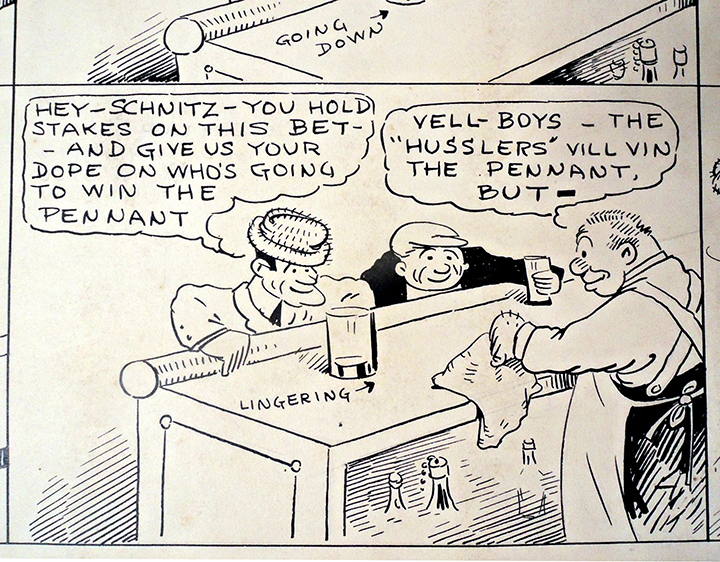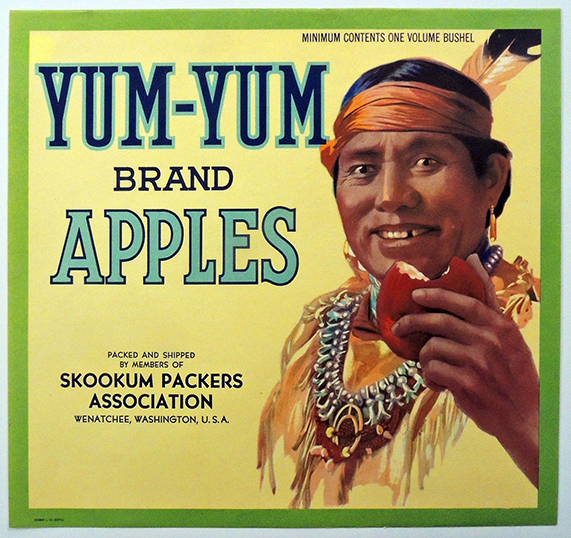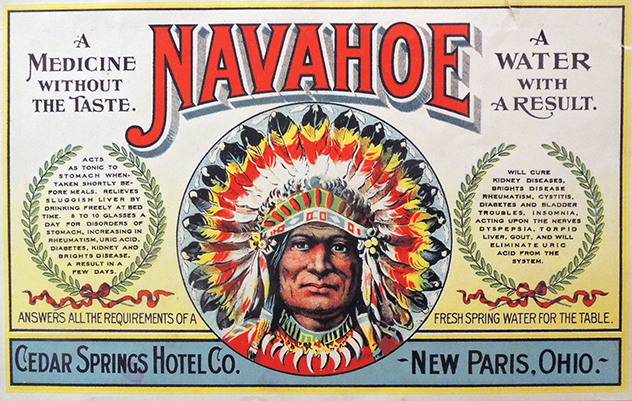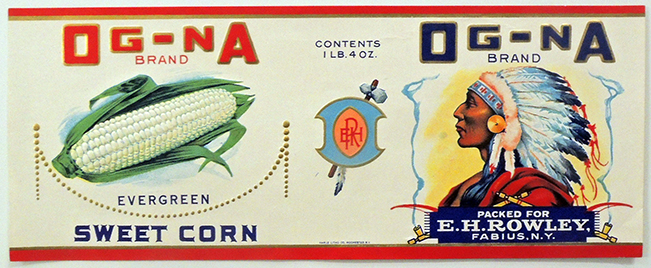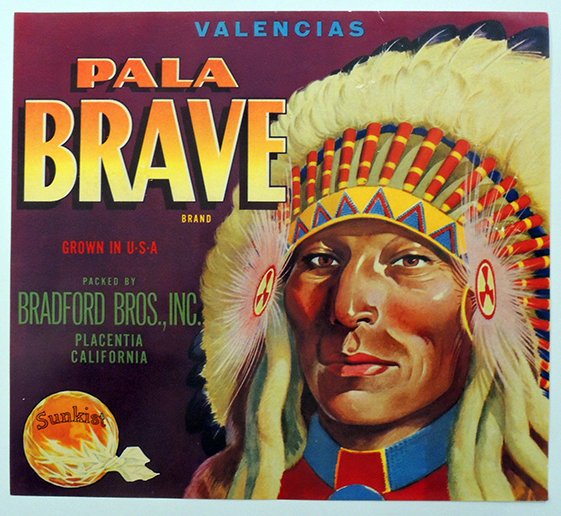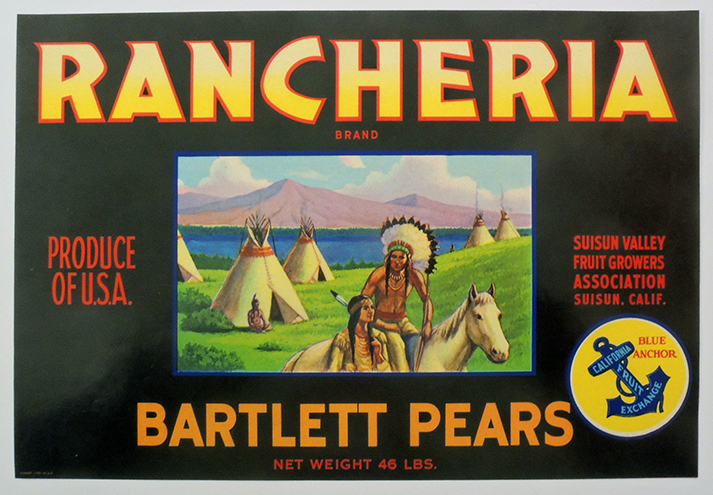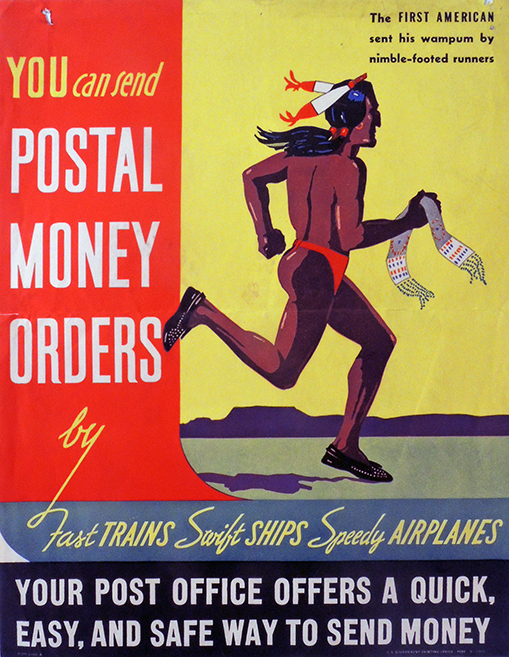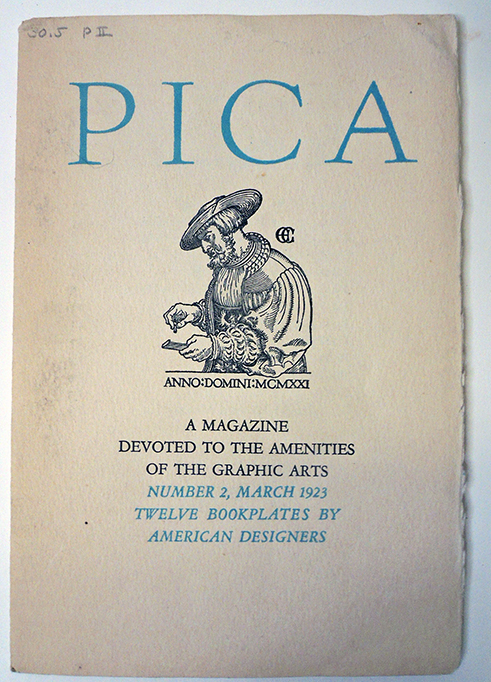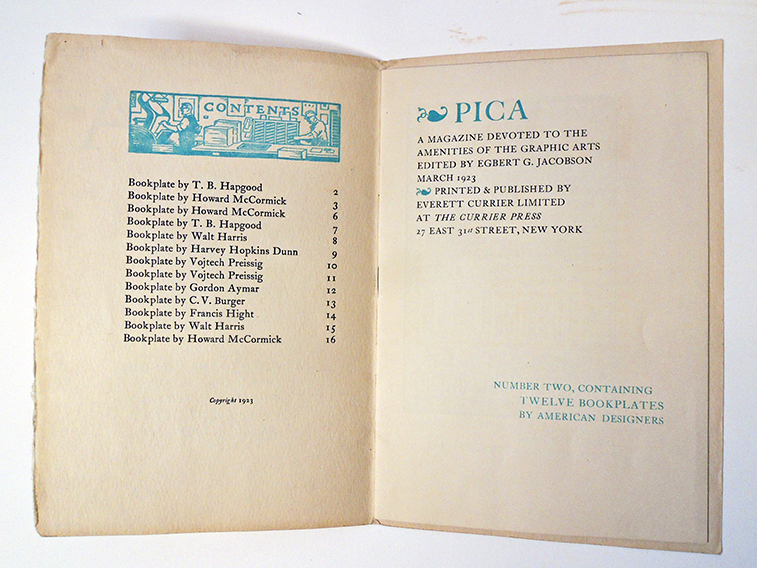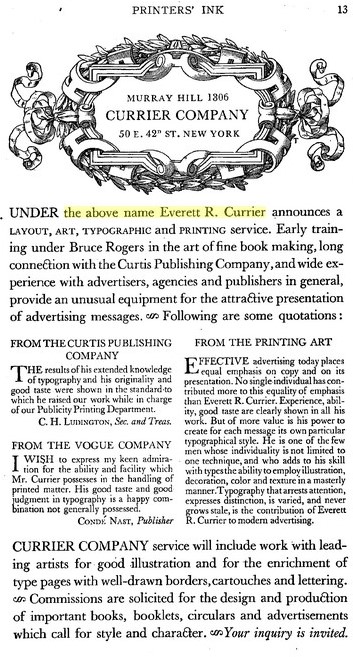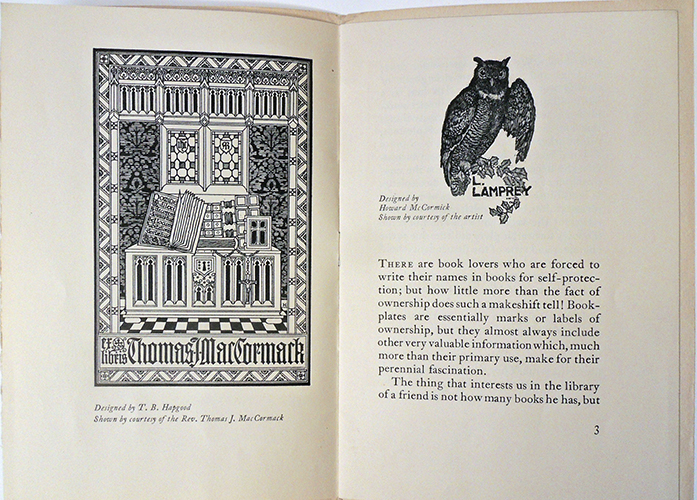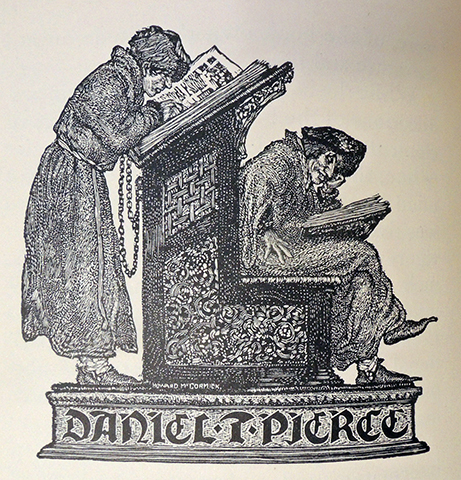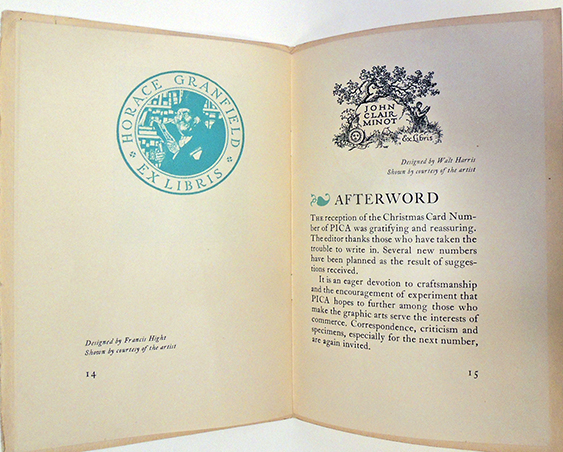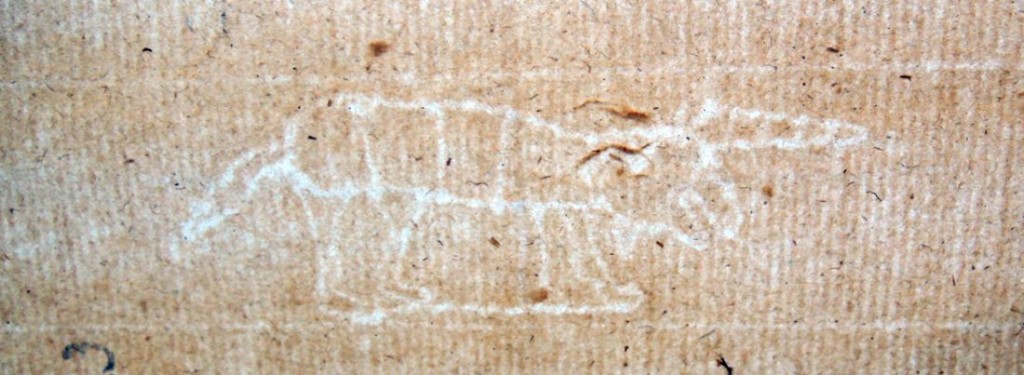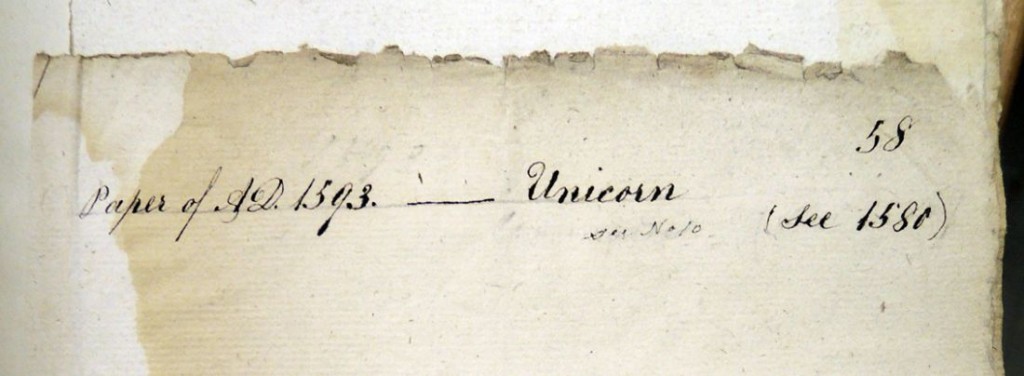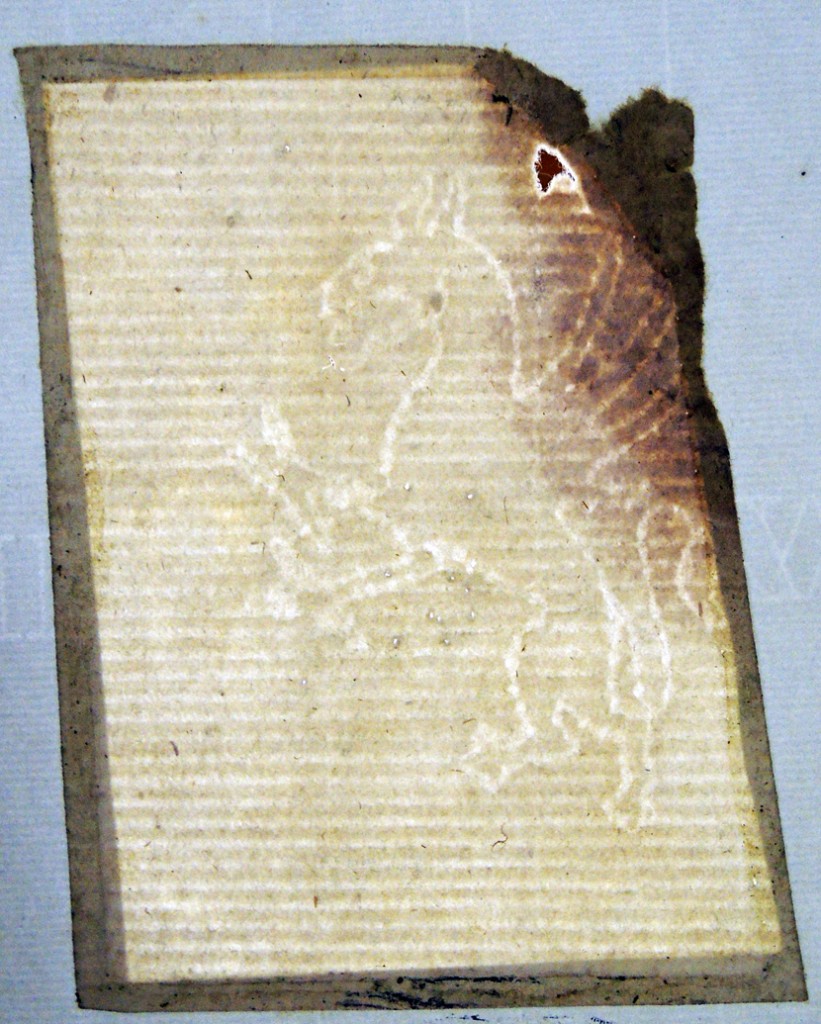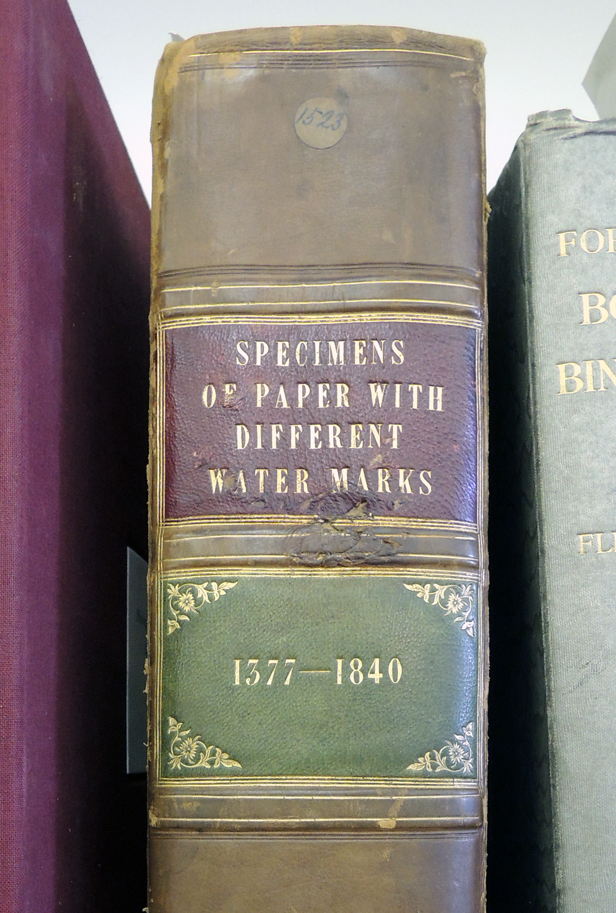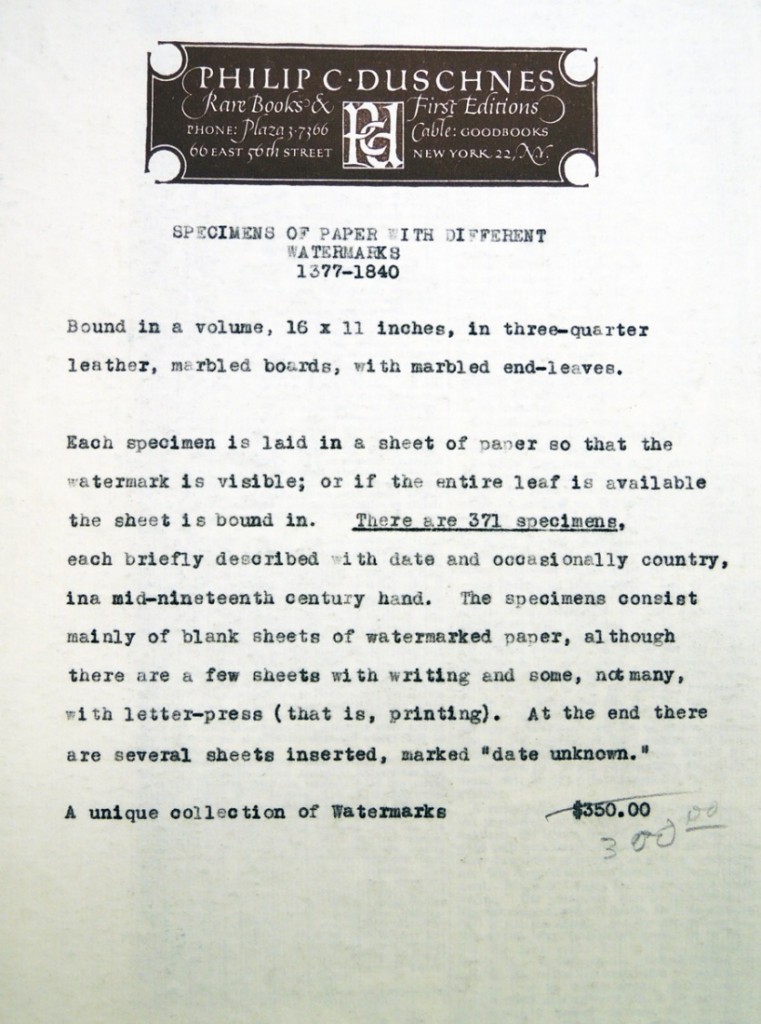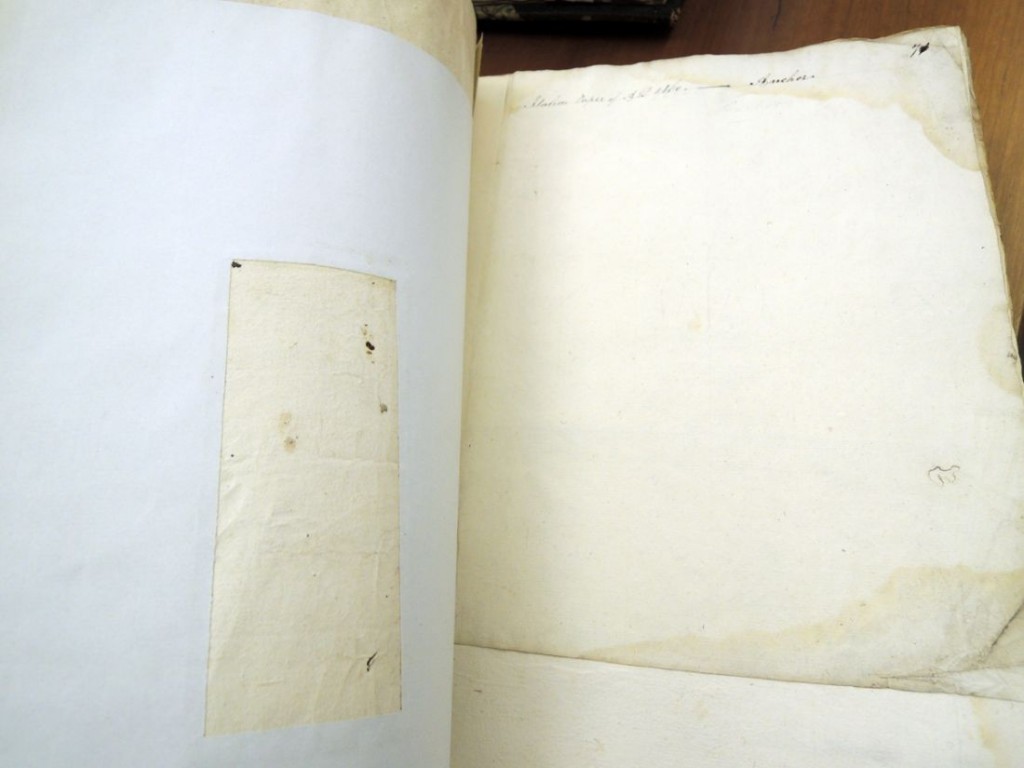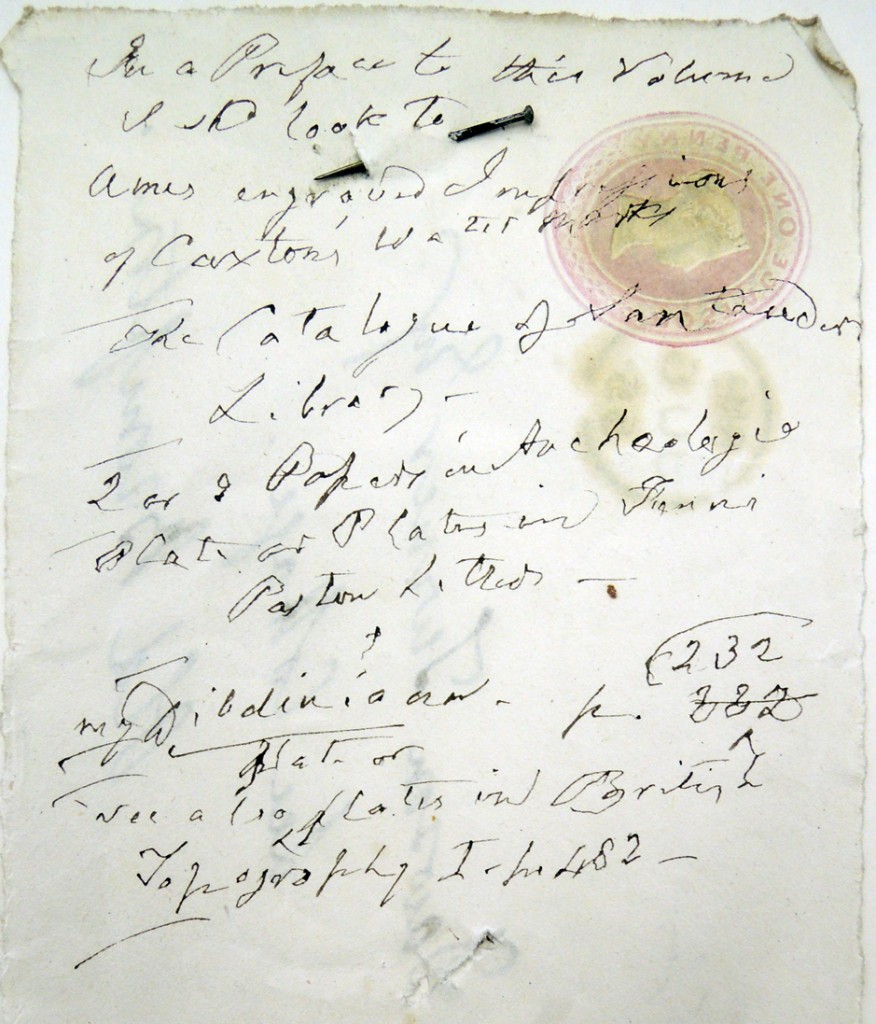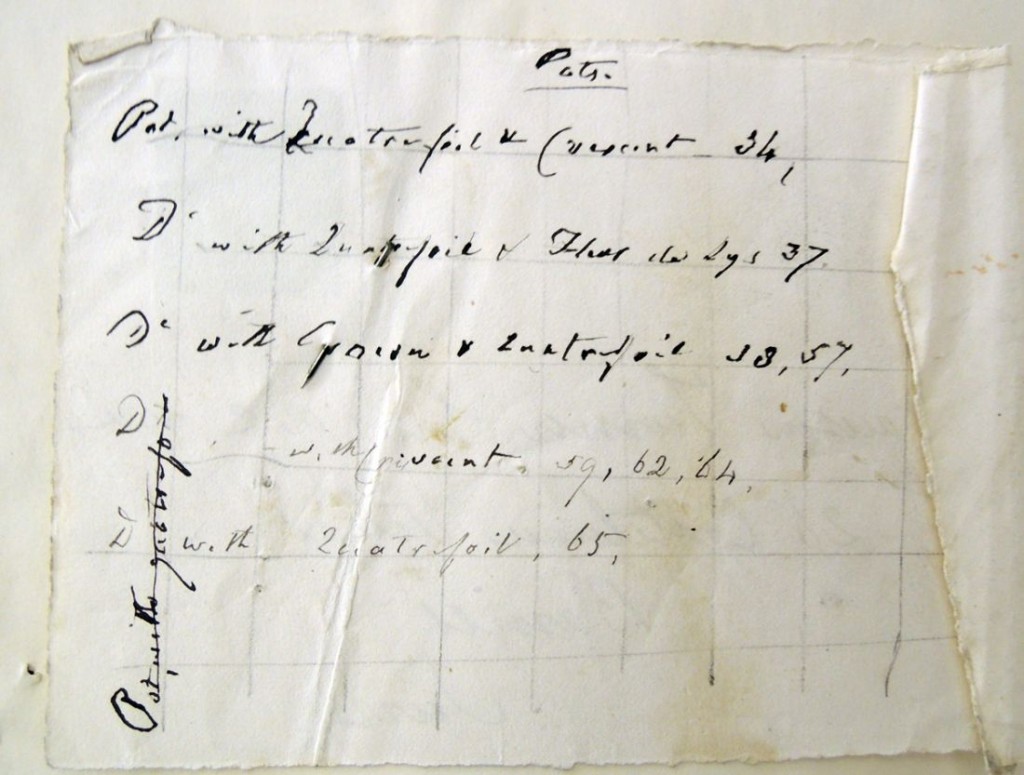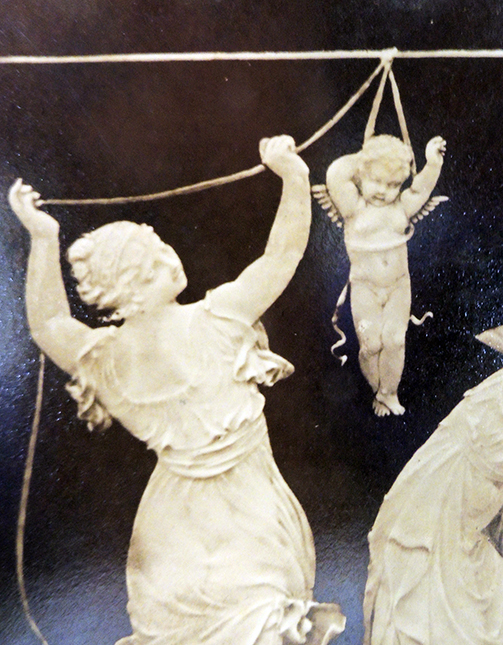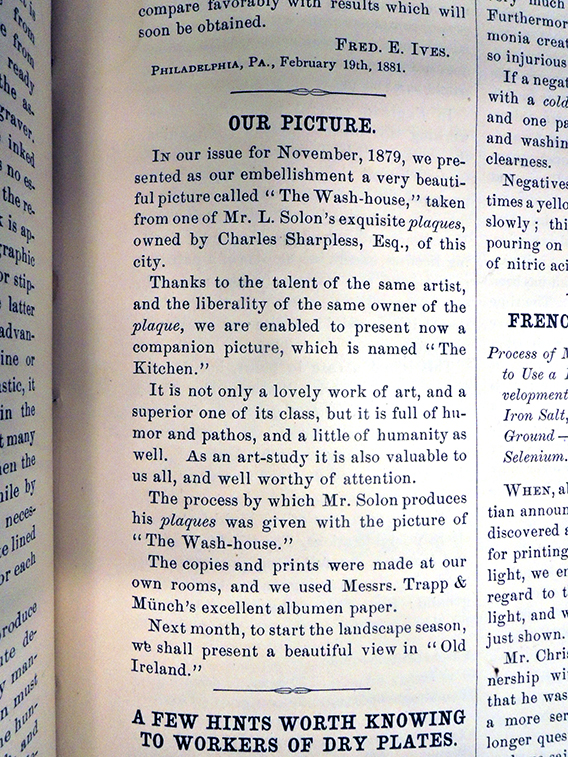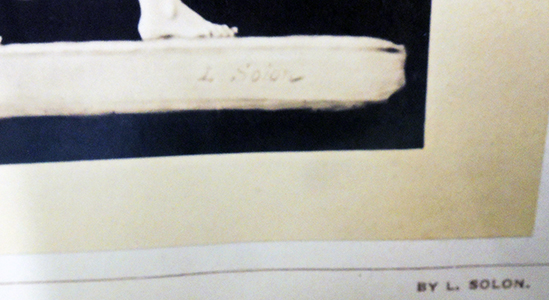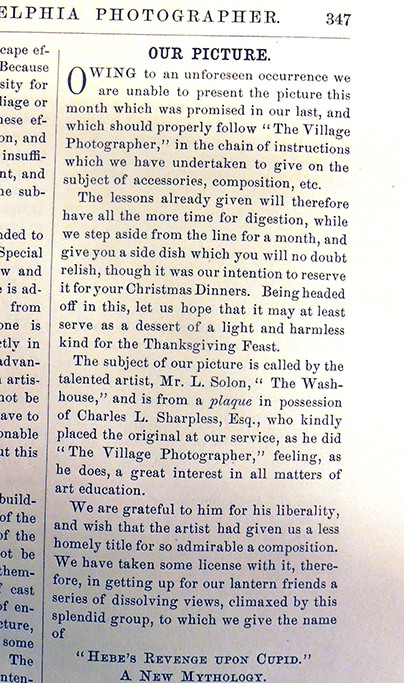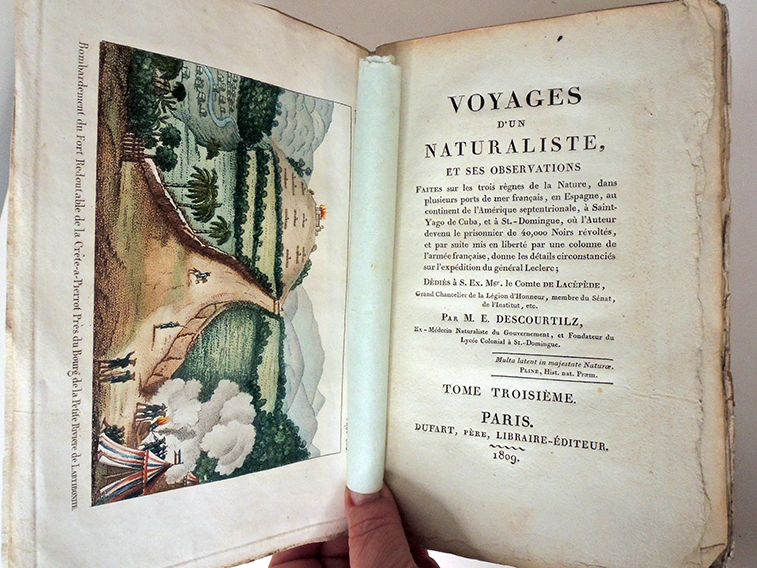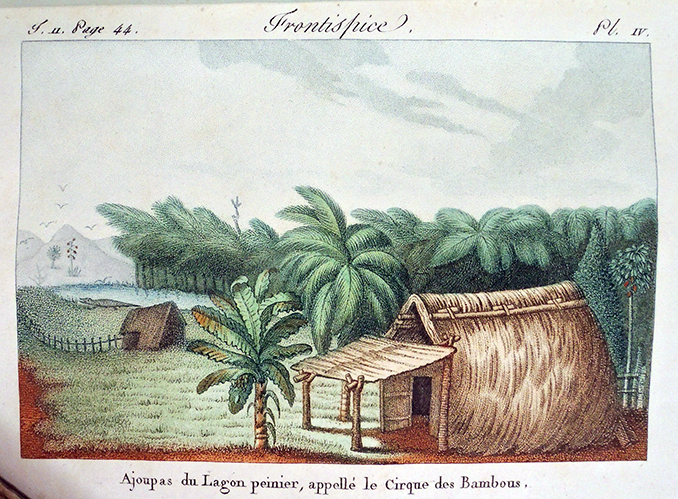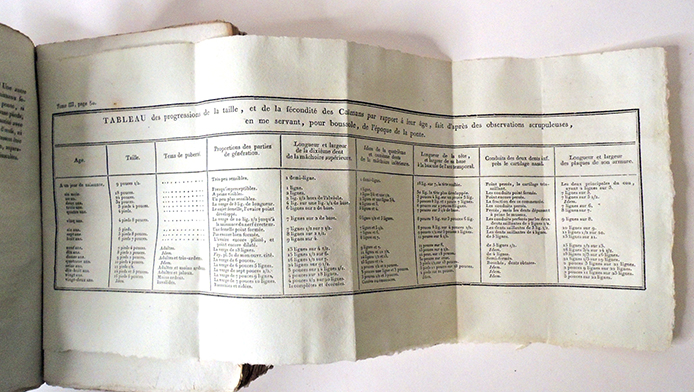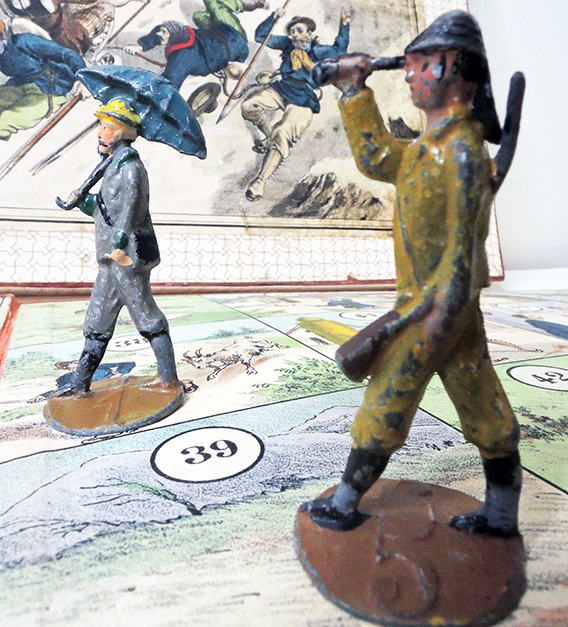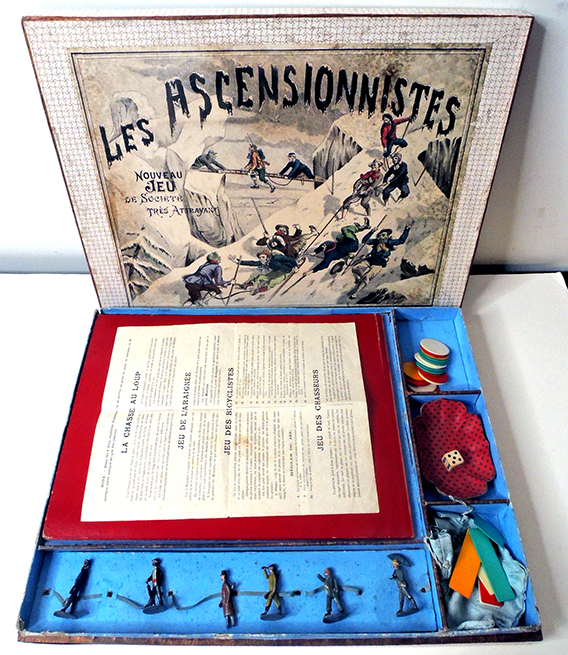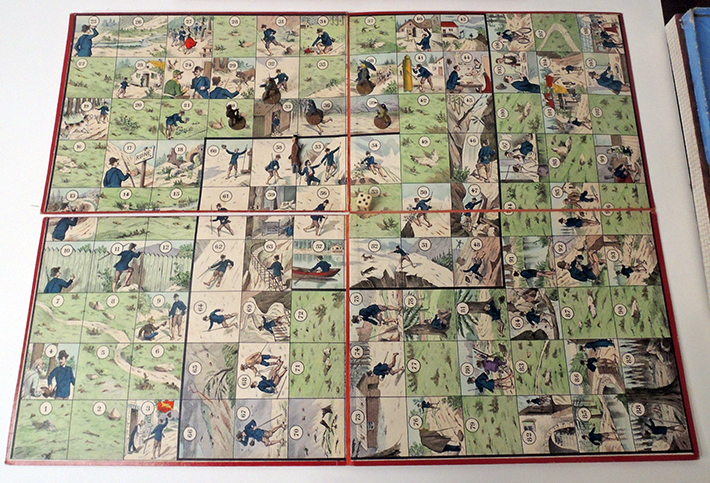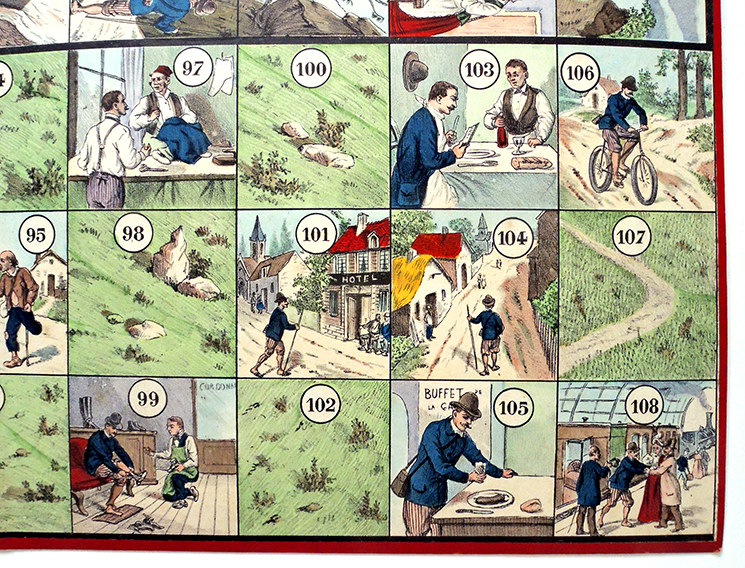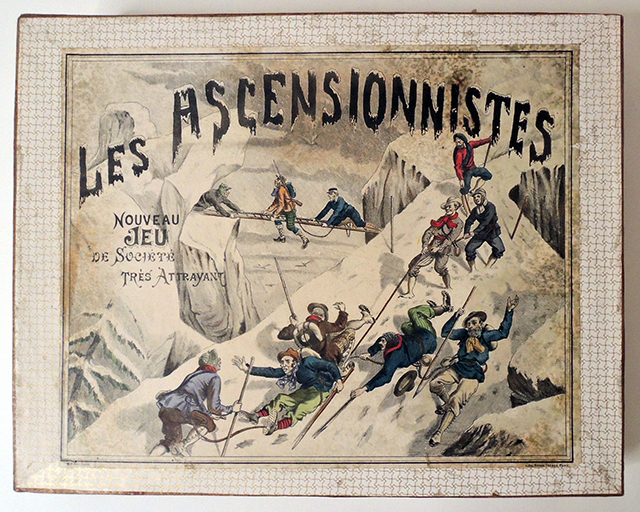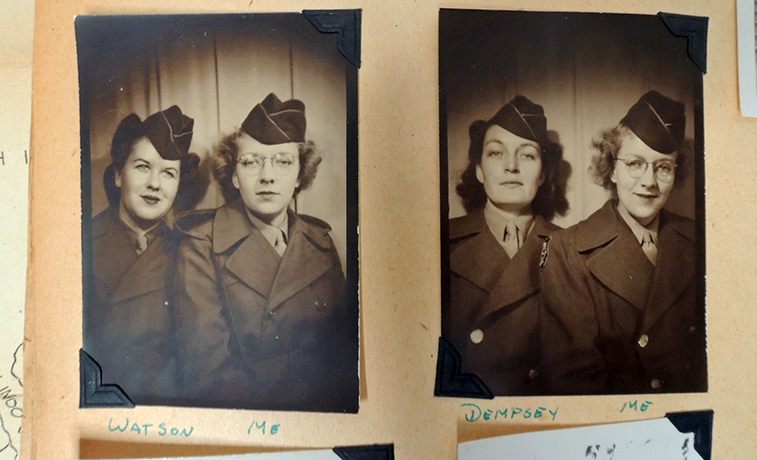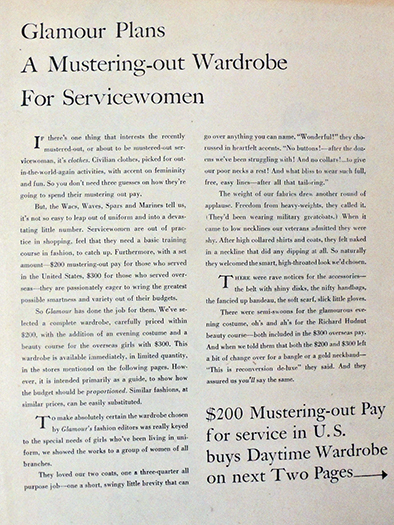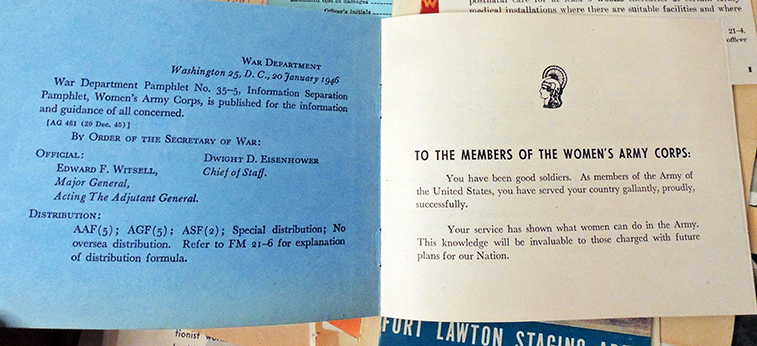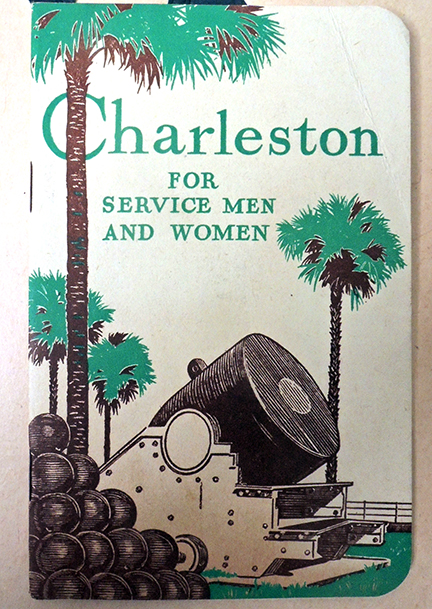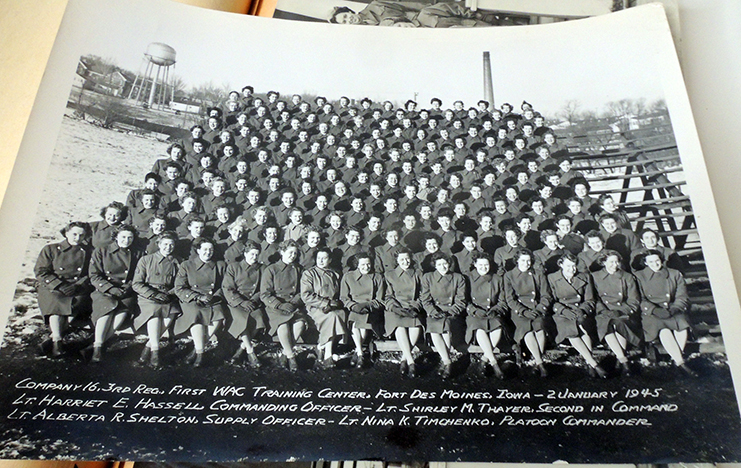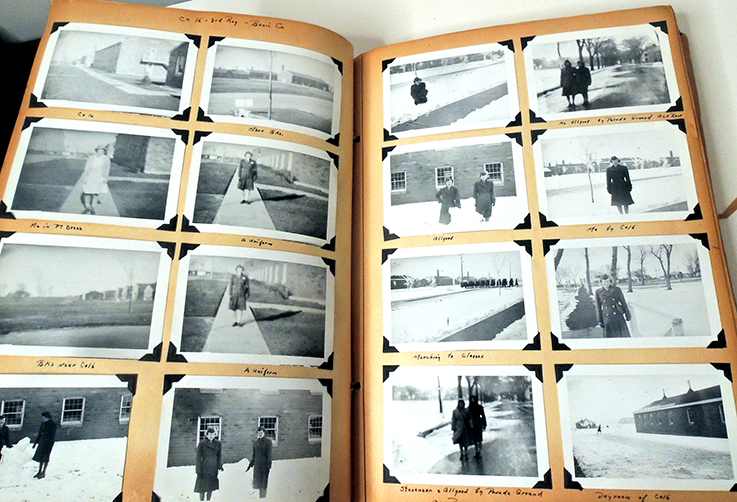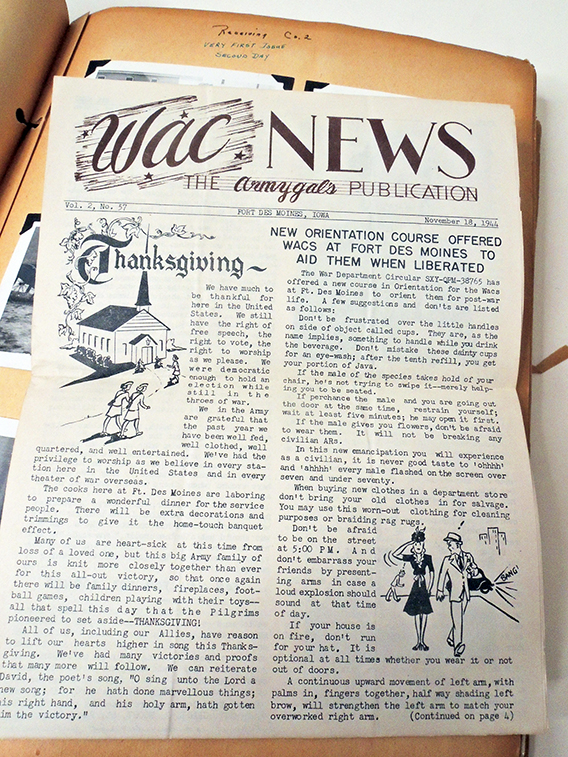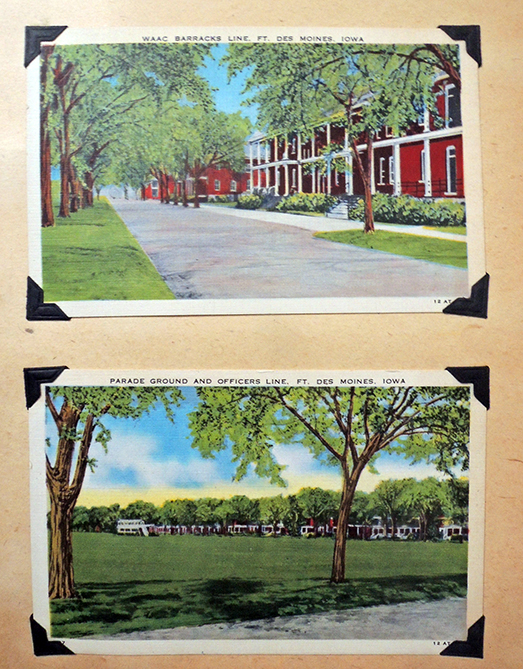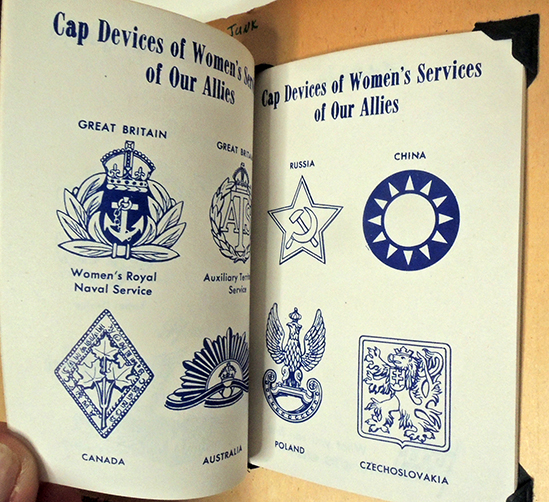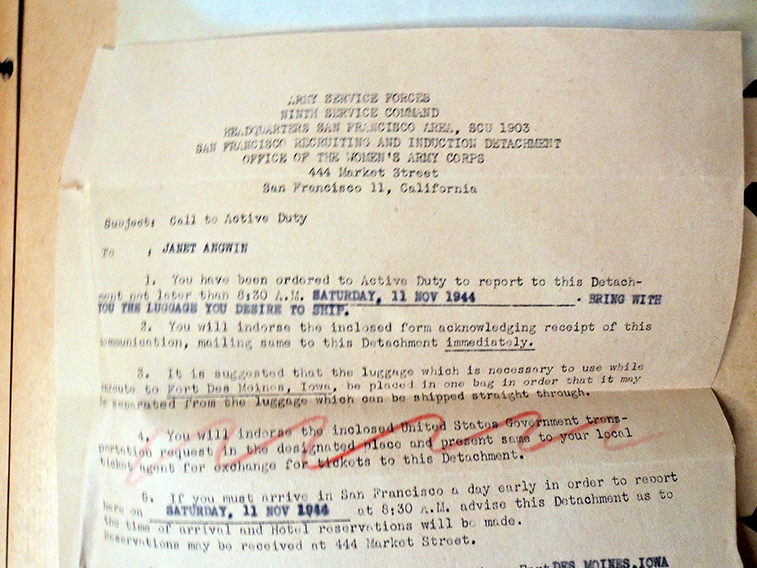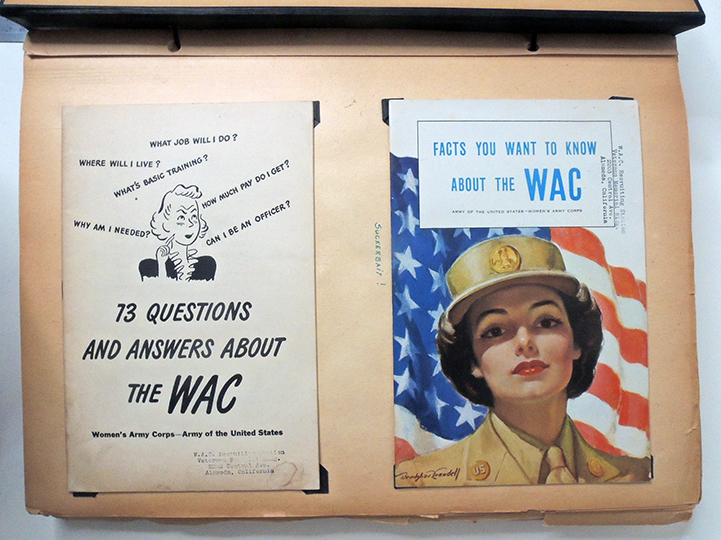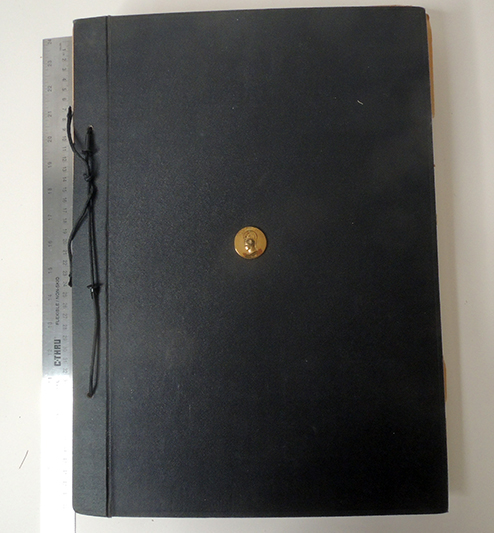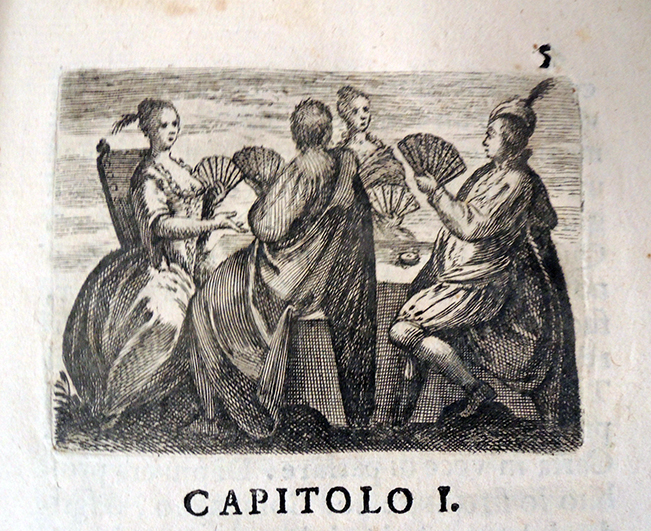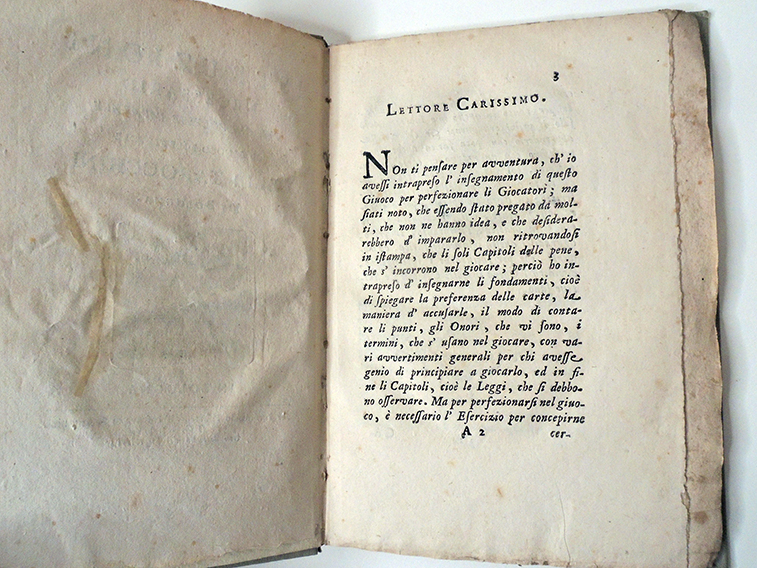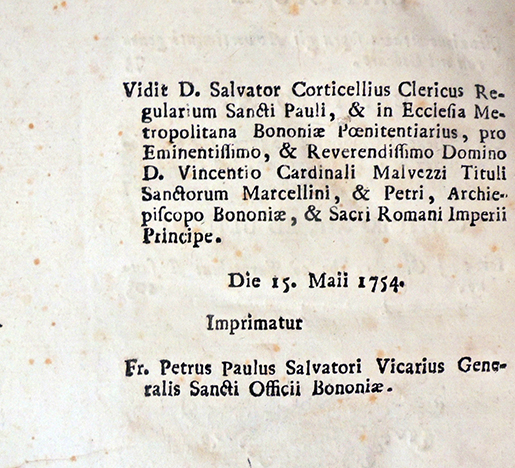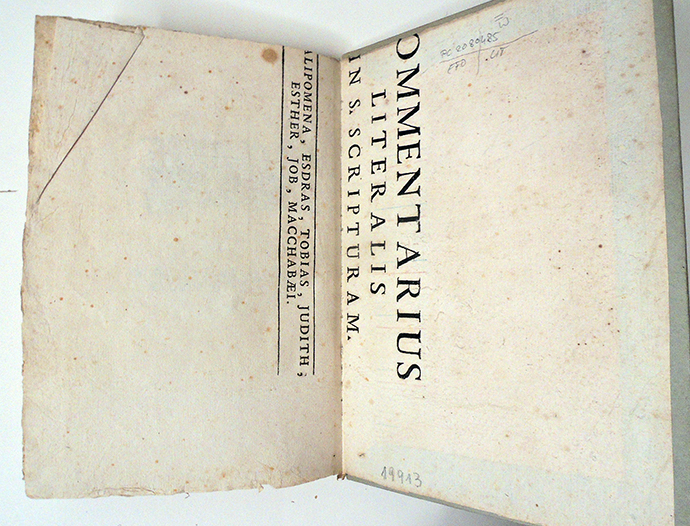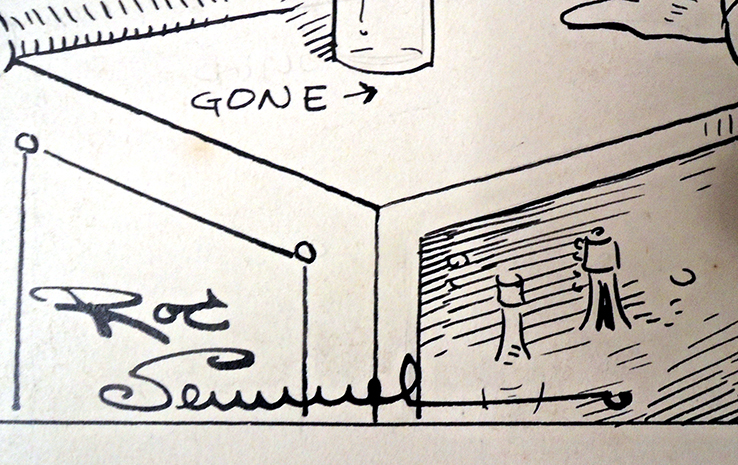
The Graphic Arts Collection holds a small selection of pen and ink drawings for early 20th-century American newspaper comic strips. Most have been identified but this signature has not been connected to a known cartoonist. Can you help? Please send your answer to jmellby@princeton.edu
Author Archives: Julie Mellby
Rethinking hurtful iconography of indigenous people in American advertising
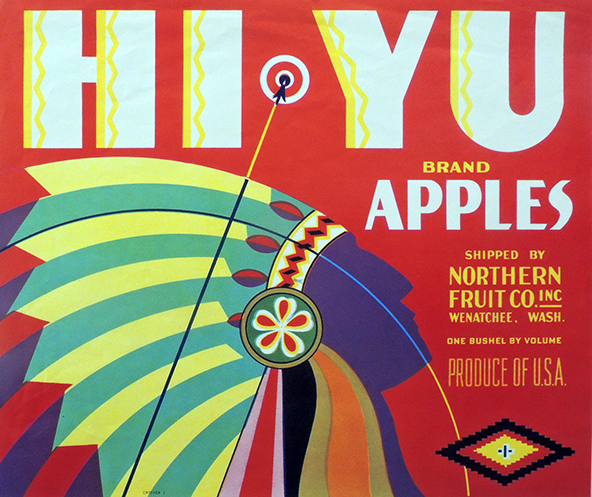
Our ephemera and advertising collection holds a number of boxes separated by particular iconography. Here are a few examples of American advertisements using Native American figures to sell various products. Hopefully all have been discontinued.
Some of these are also featured in “Americans,” a 2018 exhibition at the National Museum of the American Indian, still seen online: https://americanindian.si.edu/americans/#
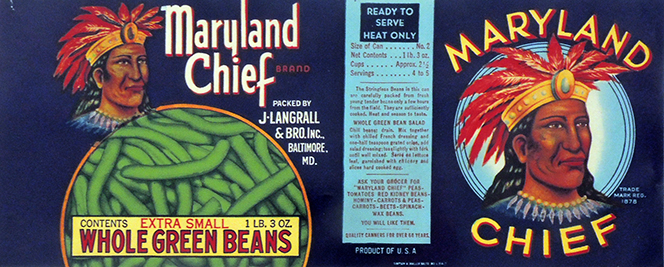 Here is the Museum’s statement calling for an end to racist mascots and images: https://www.si.edu/newsdesk/releases/ending-use-racist-mascots-and-images
Here is the Museum’s statement calling for an end to racist mascots and images: https://www.si.edu/newsdesk/releases/ending-use-racist-mascots-and-images
Everett Raymond Currier
One issue of a small printing magazine turned up recently from the Currier Press in New York City. Pica: a Magazine Devoted to the Amenities of the Graphic Arts (1922-1923) was the work of Canadian-born printer/publisher Everett Raymond Currier (1877-1954). Currier was one of a small band of white male typographers who formed the Stowaways, a private club of book and magazine designers that also included Elmer Adler (founder of the Princeton Graphic Arts Collection). See Currier below second from the right.
 Printing Arts News September 20, 1921
Printing Arts News September 20, 1921
Currier trained with Merrymount Press of D.B. Updike before working with Bruce Rogers at Riverside Press and Heintzman Press in Boston. In 1906, together with Frederic Goudy, Currier established the innovative Currier Press in New York City and later, set up companies in Chicago and Philadelphia. He wrote several manuals on type and color, advised the Conde Nast firm in the design of their periodicals, and composed religious music on the side.
Among his many publications are: Everett Raymond Currier and Bruce Rogers, Type Spacing (New York: J.M. Bowles, Norman T.A. Munder, 1910, 1912). Reprinted from the “Graphic Arts magazine of August, 1910 … and the edition is limited to three hundred copies”–Colophon.
Everett Raymond Currier, The story of Caslon Old Style (Philadelphia: Lanston Monotype Machine Co., 1915). Detached from Monotype, v. 3, no. 4, Nov.-Dec. 1915.
Mirabeau’s tribute to the memory of Benjamin Franklin : delivered at the opening of the National Assembly of France, June 11th, 1790. Printed by Everett Raymond Currier; Frederic W. Goudy, typographer, Bertha Goudy, compositor (New York: Currier Press, 1923) in American printer
 American Printer and Lithographer, Volume 72 Moore Publishing Company, 1921
American Printer and Lithographer, Volume 72 Moore Publishing Company, 1921
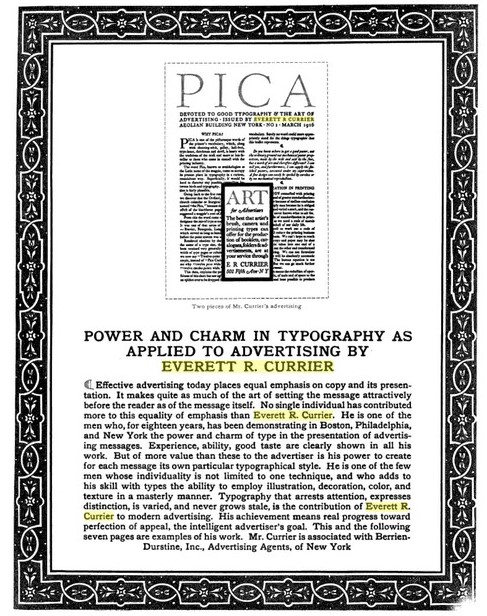 The Printing Art, Volume 41, 1923
The Printing Art, Volume 41, 1923
Reposting a very curious collection of upwards of 370 specimens of paper with various Watermarks
In honor of the 35th Biennial Congress of the International Association of Paper Historians (IPH) co-hosted by the Library of Congress, the National Gallery of Art, and the National Archives and Records Administration, currently in progress online, here is a reposting of the unusual collection of watermarks collected by Dawson Turner. This is physically in Princeton’s Graphic Arts Collection and digitized here: http://arks.princeton.edu/ark:/88435/k930bz393
During the 1952-53 fiscal year, a unique collection of nearly 400 specimens of European papers with different watermarks (1377-1840) was acquired for the Graphic Arts Collection, at the suggestion of Elmer Adler (1884-1962) with a fund turned over to the Library by the Friends of the Princeton University Library (FPUL). Adler must have been a good negotiator, talking rare book dealer Philip Duschnes down from $350 to $300.
The album was elaborately created with sheets of many shapes and sizes bound in various layers, with a brief description written at the top of each sheet. I have included the front matter pinned to the endpapers.
Originally in the collection of Dawson Turner (1775–1858), the auction catalogue description reads: ’Watermarks on Paper. A very curious collection of upwards of three hundred and seventy specimens of paper with various Watermarks, for A.D. 1377 to A. D. 1842, collected with a view to assist in ascertaining the age of undated manuscripts, and of verifying that of dated ones, by Dawson Turner, Esq. and bound in 1 vol. half calf.’
See also: Catalogue of the Remaining Portion of the Library of Dawson Turner, Esq., M.A., F.R.S., F.S.A., F.L.S., etc., etc. formerly of Yarmouth: which will be sold by auction by Messrs. Puttick and Simpson … Leicester Square … on Monday, May 16th, 1859, and seven following days (Sunday excepted). [London, 1859], item 1523.
Specimens of Paper with Different Water Marks, 1377-1840. 1 v. (unpaged); 40 cm. 371 specimens of watermarked paper, together with brief descriptions of each in a mid-nineteenth century ms. hand. The specimens are mainly blank leaves, though some leaves feature writing and letterpress. Specimen 334 is stamped sheet addressed to Dawson Turner (1775-1858), Yarmouth. Purchased with funds from the Friends of the Princeton University Library. Graphic Arts: Reference Collection (GARF) Oversize Z237 .S632f

Dawson Turner may have seen a goat, but this is a definitely a Unicorn, specifically a “bearded unicorn”, with its horn removed by Victorian scissors. The date c.1440 is almost certainly wrong; a much more plausible date is mid-1470s.
Thanks very much to Paul Needham for the correction.
Revenge upon Cupid
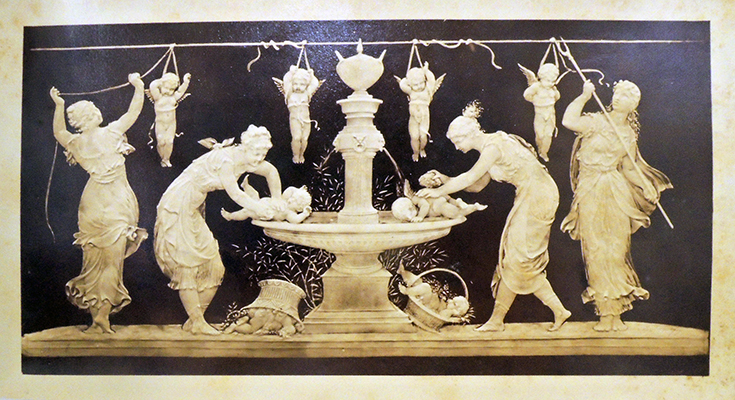 Edward L. Wilson, printed by H.C. Bridle, The Wash-House, Plaque by Marc-Louis Emanuel Solon, ca. 1876. Albumen silver print, in Wilson’s Photographic Magazine (November 1879). Graphic Arts Collection (GAX) 2007-0005M. Gift of David H. McAlpin, class of 1920.
Edward L. Wilson, printed by H.C. Bridle, The Wash-House, Plaque by Marc-Louis Emanuel Solon, ca. 1876. Albumen silver print, in Wilson’s Photographic Magazine (November 1879). Graphic Arts Collection (GAX) 2007-0005M. Gift of David H. McAlpin, class of 1920.
Every month, Edward L. Wilson (1838-1903) editor of The Philadelphia Photographer, had to print enough paper photographs to cut and paste one into each copy of his magazine. Wilson called them embellishments and believed there was no substitute for the real thing, when introducing his readers to various photographic processes. Beginning with albumen silver prints, over the years readers received examples of Woodburytypes, carbon prints, photogravure, photo-engraving, and more. A commentary was published for each print, providing the chemistry and equipment used, along with other details so the photograph could be replicated.
From 1864 to 1901 (when photographs were replaced by halftones), Wilson published 540 prints by 280 photographers from 142 cities in 16 countries. Within the United States alone, negatives were sent by photographers in thirty-three different states, remarkable given there were only thirty-six states total in 1864 and forty-four by 1890.
Once in a while, a photographer failed to provide the negatives that were promised, or poor weather interfered with the production of sun printed positives, leaving Wilson without the necessary prints for the upcoming issue. This was the case in November 1879 and again in March 1881. In each case Wilson made his own photographic negative that was editioned by H.C. Bridle, in Wilson’s Philadelphia studio.
The image for each print was a plaque designed by Marc-Louis Emanuel Solon (1835-1913), and produced by Mintons Ltd., Stoke-on-Trent, England. Solon specialized in porcelain decoration called pâte-sur-pâte or paste on paste, produced first at Sèvres in France and then in England at the Mintons factory. The first was called “The Wash-House” and the second “Kitchen,” both purchased by Charles L. Sharpless after the display at the 1876 Philadelphia World’s Fair.
Edward L. Wilson, printed by H.C. Bridle, Kitchen, Plaque by Marc-Louis Emanuel Solon, ca. 1876. Albumen silver print, in Wilson’s Photographic Magazine (March 1881). Graphic Arts Collection (GAX) 2007-0005M. Gift of David H. McAlpin, class of 1920.
Voyages d’un naturaliste et ses observations
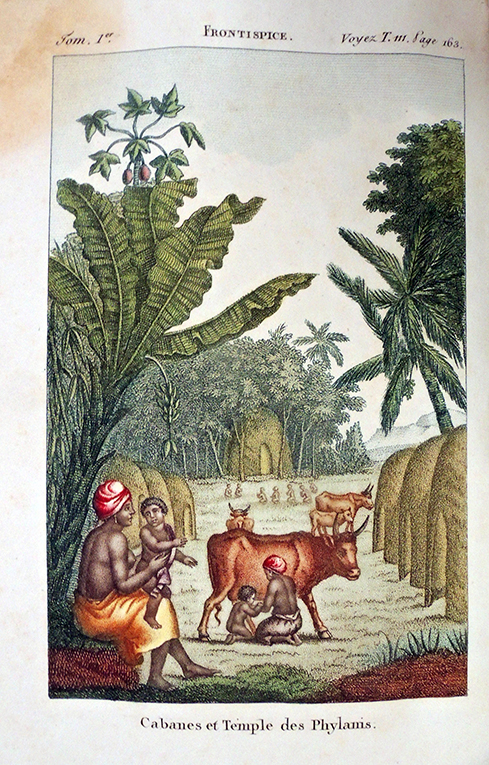
In 1799, Michel Etienne Descourtilz, a French naturalist and surgeon, arrived at Saint Domingue on the Caribbean island of Hispaniola and remained there nearly four years, during which time the indigenous people revolted. Today the island hosts the Dominican Republic and Haiti. Although Descourtilz collected samples, documented language and music, and made sketches, many of his belongings were destroyed during the revolution. Returning to Paris, it took him five more years to complete his narrative, first published in 1809.
“The first-person accounts by whites taken prisoner during the interracial violence in Saint-Domingue during the revolutionary era … were written primarily to refute opponents of slavery in revolutionary France. Precisely because their authors had personally confronted a situation in which black slaves had at least provisionally defeated the white world-the only such situation in the Atlantic world up to that time-these narratives are of extraordinary interest for the development of modern discourses about race and identity.
The Saint-Domingue insurrection, which began in 1791 and culminated in the creation of the independent black republic of Haiti in 1804, has haunted thinking about race throughout the Western world ever since. …The insurrection demonstrated that people of color could not only be active agents in the making of history, but that they could overthrow white rule and seize control of the crown jewel of one of the great European empires, the most valuable piece of colonial real estate in the world at the time. Toussaint Louverture, the black leader who emerged to lead this movement, represented slaveholders’ worst nightmare, and his saga became an inspiration for movements for freedom among people of color on both sides of the Atlantic.
Compared to the number of narratives about North American whites captured by Native Americans or white Europeans enslaved in the “Barbary states” of North Africa, the corpus of first-person testimonies from the Saint-Domingue uprising is small. Only two fairly lengthy accounts published at the time are known: the colonist Gros’s Historick Recital, of the Different Occurrences in the Camps of Grand-Reviere…, and the naturalist Michel Etienne Descourtilz’s Voyages d’un naturaliste, which recounts the author’s experiences from 1799 to 1803, during Toussaint’s reign and in the war which resulted in the destruction of the last vestiges of white rule in Haiti.” —Jeremy D. Popkin, “Facing Racial Revolution: Captivity Narratives and Identity in the Saint-Domingue Insurrection,” Eighteenth-Century Studies , Summer, 2003, Vol. 36, No. 4 (Summer, 2003) URL: https://www.jstor.org/stable/30053605
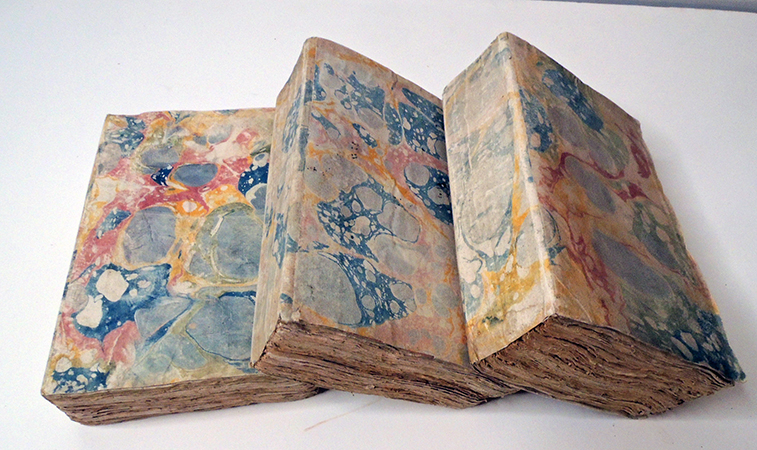 Michel Etienne Descourtilz (1775-1835), Voyages d’un naturaliste, et ses observations : faites sur les trois règnes de la nature, dans plusieurs ports de mer français, en Espagne, au continent de l’Amérique Septentrionale, à Saint-Yago de Cuba, et à St.-Domingue, où l’auteur devenu le prisonnier de 40,000 Noirs révoltés, et par suite mis en liberté par une colonne de l’armée française, donne des détails circonstanciés sur l’expédition du général Leclerc [Travels of a naturalist, and his observations: made on the three kingdoms of nature, in several French seaports, in Spain, in the continent of North America, in Saint-Yago de Cuba, and in Santo Domingo, where the author who became the prisoner of 40,000 revolting indigenous people, and consequently released by a column of the French army, gives detailed details of the expedition of General Leclerc] (Paris: Dufart père, 1809). Complete with 45 full-page colored stipple engravings (3 frontispieces); a conversation in Creole; and two local songs with musical scores. Graphic Arts Collection GAX2021- in process
Michel Etienne Descourtilz (1775-1835), Voyages d’un naturaliste, et ses observations : faites sur les trois règnes de la nature, dans plusieurs ports de mer français, en Espagne, au continent de l’Amérique Septentrionale, à Saint-Yago de Cuba, et à St.-Domingue, où l’auteur devenu le prisonnier de 40,000 Noirs révoltés, et par suite mis en liberté par une colonne de l’armée française, donne des détails circonstanciés sur l’expédition du général Leclerc [Travels of a naturalist, and his observations: made on the three kingdoms of nature, in several French seaports, in Spain, in the continent of North America, in Saint-Yago de Cuba, and in Santo Domingo, where the author who became the prisoner of 40,000 revolting indigenous people, and consequently released by a column of the French army, gives detailed details of the expedition of General Leclerc] (Paris: Dufart père, 1809). Complete with 45 full-page colored stipple engravings (3 frontispieces); a conversation in Creole; and two local songs with musical scores. Graphic Arts Collection GAX2021- in process
Links to our webinar recordings
Looking back at the past sixteen months of virtual sharing, here is a recap of the webinars presented to highlight special collections at Princeton University Library, hosted by Julie Mellby. Many have been recorded and archived at: https://mediacentral.princeton.edu/esearch/search?keyword=mellby
 New Theories on the Oldest American Woodcut. May 22, 2020
New Theories on the Oldest American Woodcut. May 22, 2020
To celebrate the 350th anniversary of the oldest surviving print from Colonial America, we assembled all five extent copies of the portrait of the Reverend Richard Mather (1596-1669) by or after John Foster. Julie Mellby was joined by Caroline Duroselle-Melish, Andrew W. Mellon Curator of Early Modern Books and Prints and Associate Librarian for Collection Care and Development, Folger Shakespeare Library. https://mediacentral.princeton.edu/media/New%20Theories%20on%20the%20Oldest%20American%20Woodcut%3A%20The%20Portrait%20of%20Richard%20Mather%20by%20John%20Foster%2C%20ca.%201670/1_s9zed1co
Thomas Eakins and the Making of Walt Whitman’s Death Mask. June 26, 2020
This program was chosen specifically for June, LGBTQ pride month and this year, the 50th anniversary of the first Gay Pride march. Both Walt Whitman and Thomas Eakins, in their own way, broke down barriers around sex, sexuality, and the celebration of the human body. Presented by Julie Mellby, Graphic Arts Curator, and Karl Kusserow, John Wilmerding Curator of American Art, Princeton University Art Museum.
Afrofuturism: The Graphics of Octavia E. Butler. July 31, 2020
This month focused on the speculative fiction, also called Afrofuturism, of author Octavia E. Butler. Julie Mellby was joined by Damian Duffy and John Jennings, the award winning team who produced the graphic novel adaptations of Parable of the Sower and Kindred. https://mediacentral.princeton.edu/media/Afrofuturism%3A%20The%20Graphics%20of%20Octavia%20Butler/0_sxt5w106
Celebrate the 100th Anniversary of Women’s Suffrage. August 26, 2020
The fourth in our series celebrated the centenary of the 19th amendment on Women’s Equality Day. Julie Mellby was joined by Lauren Santangelo, author of Suffrage and the City and lecturer in Princeton University’s Writing Program, along with Sara Howard, Librarian for Gender & Sexuality Studies and Student Engagement within Scholarly Collections and Research Services at Princeton University Library. https://mediacentral.princeton.edu/media/Celebrate%20the%20100th%20Anniversary%20of%20Women%E2%80%99s%20Suffrage/0_2cr7iatx
The Books and Prints of Anaïs Nin and her Gemor Press, September 25, 2020
Recently we acquired most of the rare letterpress editions printed by Anaïs Nin (1903-1977). Best known for her diaries, Nin also wrote fiction with themes of history, feminism and multiculturalism. Together with Gonzalo More, Nin ran a private printing press in Greenwich Village where she taught herself to set type, stood for hours pumping a treadle press, and distributed her books with the help of Frances Steloff at Gotham Book Mart. After a close look at the books and prints by Julie Mellby, we are joined by Andrew Berman, Executive Director of the Greenwich Village Society for Historic Preservation, who will update us on their efforts to landmark this building. https://mediacentral.princeton.edu/media/The%20Books%20and%20Prints%20of%20Ana%C3%AFs%20Nin%20and%20her%20Gemor%20Press/1_eeskb4kg
Before Zoom, Pre-Cinema, Optical Devices Tour, December 4, 2020
A virtual tour highlighting our collection of pre-zoom, pre-cinema optical devices, rare artifacts designed for shared public entertainment or personal moments of wonder, leading up to the invention of the motion picture. Through a series of live webcams (yikes, not prerecorded), Julie Mellby attempted the phantasmagoria experienced in the past as we peer into 18th-century peepshows, twirl phenakistoscopes, open a gigantic megalethoscope and crank a miniature cinematograph. She was joined by Christopher Collier, Executive Director, and Jesse Crooks, Operations Director and Head Projectionist for Renew Theaters, who will share some of the history and treasures of Princeton’s Garden Theater. https://mediacentral.princeton.edu/media/Before%20Zoom%3A%20Cinema%2C%20the%20Zoetrope%2C%20and%20other%20Optical%20Devices/1_slloy021
Acrobatics: Moving Through the Trans Archives, February 26, 2021
Our title refers to the celebrated career of the 19th-century gender-fluid acrobat Mademoiselle Lulu (Sam Wasgott), with whom we begin our discussion. From there we will move through 20th and 21st century materials that define the trans archive, with an emphasis on race as well as gender. We are thrilled to be joined by RL Goldberg (they/them), English Department and Associate Director, Behrman Undergraduate Society of Fellows, in dialogue with queer book dealer, collector, and historian Gerard Koskovich (he/him); along with Sara Howard (she/her), Librarian for Gender and Sexuality Studies and Student Engagement, and Julie Mellby (she/her), Graphic Arts Curator. https://mediacentral.princeton.edu/media/Acrobatics%3A%20Moving%20Through%20the%20Trans%20Archives/1_bj4vn4m8
Mithila Art in 2020: Life, Labor, and COVID-19 in South Asia, March 26, 2021
Throughout 2020, artists in South Asia have been engaging with pandemic-related themes that reflect the vast inequity with which the pandemic has manifested in the lives those citizens. While some have managed to maintain safety and stability, many more have experienced food insecurity, displacement, disease, and loss of income. The Mithila art in Princeton’s collection expresses moments of both serenity and sorrow in the midst of the recent crisis. Panelists will discuss and reflect on the particular expressions of COVID-19 in this art, as well the impact of the pandemic on artisan labor and art markets. The panel discussion included Amanda Lanzillo, Cotsen Postdoctoral Fellow in the Society of Fellows; Lina Vincent, art historian and curator based in Goa, India; and Peter Zirnis, curator and collector of Mithila art; hosted by Julie Mellby, Graphic Arts Curator and Ellen Ambrosone, South Asian Studies Librarian. https://mediacentral.princeton.edu/media/Mithila%20Art%20in%202020%3A%20Life%2C%20Labor%2C%20and%20COVID-19%20in%20South%20Asia/1_gbnyavml
April is for the Birds: From Audubon’s Extraordinary Birds of America to the Indispensable Pocket Field Guides, April 30, 2021
As we have done for our students, we paged through multiple volumes so viewers can experience the colossal scale of Audubon’s birds, painted life-size and then transferred to copper plates for the printing and painting of the published ‘double-elephant’ volumes. Introducing us to Audubon’s remarkable work is Rachael Z. DeLue, Christopher Binyon Sarofim ’86 Professor in American Art, Professor of Art and Archaeology and American Studies, and the current Chair of the Department of Art and Archaeology at Princeton University. Julie Mellby, Graphic Arts Curator, focused on master printer Robert Havell, Jr. who took Audubon’s paintings and transformed them into 435 aquatints. Finally, Robert Kirk, Publisher, Princeton Nature, with Princeton University Press who brought us up to date with the field guides used by birders. https://mediacentral.princeton.edu/media/Virtual%20Birding%3A%20Exploring%20Audubon’s%20’Birds%20of%20America’/1_ymiadleu
The Princeton Print Club, May 28, 2021
The initial idea was for Adler, with his large collection of books, plates and prints, to give informal courses in the graphic arts that would serve to stimulate the cultural interests of Princeton undergraduates. A group of students decided to go further by forming an organization whose activities would revolve around 40 Mercer (later 36 University Place) and so it was that the Princeton Print Club came into existence. Julie Mellby presented an illustrated history of the organization, joined by Marilyn Kushner, New York Historical Society, who talked about the explosion of interest in printing and print collecting at that time, and by Alexandra Letvin, from the Allen Memorial Art Museum, Oberlin College, where they continue to circulate fine art prints to the students each semester as part of their Art Rental program.
https://mediacentral.princeton.edu/media/The%20Princeton%20Print%20Club/1_r5mjkwav
Les Ascensionnistes
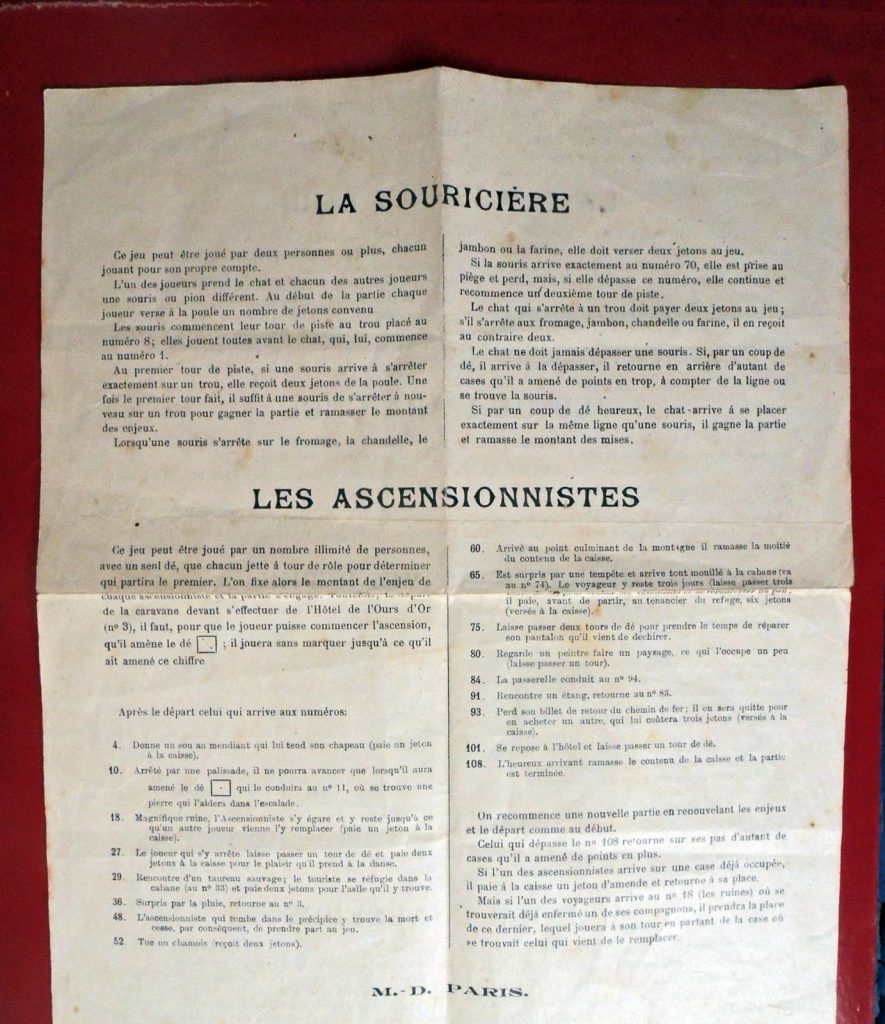 Les Ascensionnistes. Nouveau jeu de Société très Attrayant, [The Mountaineers: An Attractive New Board Game]. (Paris: MD [Mauclair & Dacier]; Printed at Roches Frères, ca. 1885). Graphic Arts Collection GAX 2021- in process
Les Ascensionnistes. Nouveau jeu de Société très Attrayant, [The Mountaineers: An Attractive New Board Game]. (Paris: MD [Mauclair & Dacier]; Printed at Roches Frères, ca. 1885). Graphic Arts Collection GAX 2021- in process
The game’s decorated box holds a folding chromolithographic board with 108 numbered squares; six hand painted die-cast figures; 32 white and coloured playing tokens in a bag; a shaped paper-mâché tray; a bone dice; and printed instructions. According to the online Game of the Goose database (http://www.giochidelloca.it/anteprime.php?pagina=40&ordine=anno) this is the same game published by Simonin-Cuny and similar game reset with different title (Jeu des Alpinistes. Nouveau Jeu très Amusant) also published by Simonin-Cuny.
The firm of Mauclair-Dacier, located on 5 rue Haudriette in Paris (with a factory on 148 avenue Daumesnil), specialized in manufacturing and selling toys and games. It was active from the 1880s until it was acquired by the firm of Les Jeux Réunis in 1904. Visit the Mauclair-Dacier game factory: http://www.jeuxanciensdecollection.com/article-visite-de-l-usine-modele-mauclair-dacier-121197715.html
 Illustrations from Henriette de Beaumont d’Angeville (1794-1871), My ascent of Mont Blanc; with a preface by Dervla Murphy ; translated from the French by Jennifer Barnes (London: HarperCollins, 1991). ReCAP, GV199.92.A54 A3 1991.
Illustrations from Henriette de Beaumont d’Angeville (1794-1871), My ascent of Mont Blanc; with a preface by Dervla Murphy ; translated from the French by Jennifer Barnes (London: HarperCollins, 1991). ReCAP, GV199.92.A54 A3 1991.
 The Mountaineers game, exclusively designed around male climbers, reminds us of Henriette d’Angeville (1794–1871), “reported to have been the first woman to climb Mont Blanc, the highest mountain in the French Alps. True, Marie Paradis, a local peasant, driven by the lure of financial gain and encouraged by fellow adventurers, had gone to the top in 1808. But unlike her, d’Angeville made the decision to attempt the feat without the encouragement of others, preparing and paying for the trip herself. Her success earned her recognition as the first climber of the “weaker sex” to reach the summit of Mont Blanc. Surprisingly, the feat received little commentary, except in books on the history of mountaineering where a few scattered passages mentioned her – sometimes in disparaging terms.”–Women in Trousers: Henriette d’Angeville, a French Pioneer? By Pascale Gorguet Ballesteros. 04 Nov 2016 https://doi.org/10.1080/17569370.2016.1215112
The Mountaineers game, exclusively designed around male climbers, reminds us of Henriette d’Angeville (1794–1871), “reported to have been the first woman to climb Mont Blanc, the highest mountain in the French Alps. True, Marie Paradis, a local peasant, driven by the lure of financial gain and encouraged by fellow adventurers, had gone to the top in 1808. But unlike her, d’Angeville made the decision to attempt the feat without the encouragement of others, preparing and paying for the trip herself. Her success earned her recognition as the first climber of the “weaker sex” to reach the summit of Mont Blanc. Surprisingly, the feat received little commentary, except in books on the history of mountaineering where a few scattered passages mentioned her – sometimes in disparaging terms.”–Women in Trousers: Henriette d’Angeville, a French Pioneer? By Pascale Gorguet Ballesteros. 04 Nov 2016 https://doi.org/10.1080/17569370.2016.1215112
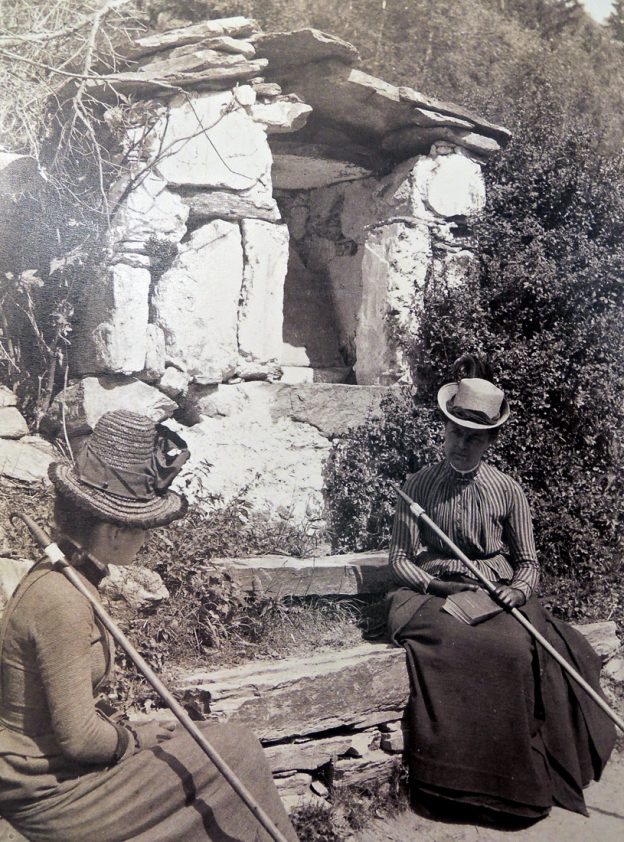 Less distinguished but equally ambitious was Helen Henderson Chain, wife of James A. Chain. Both were artists and avid climbers as seen in the photographs of their 1888 trip to Germany, Switzerland, and Italy. https://wp.me/p3KgmJ-4Wu
Less distinguished but equally ambitious was Helen Henderson Chain, wife of James A. Chain. Both were artists and avid climbers as seen in the photographs of their 1888 trip to Germany, Switzerland, and Italy. https://wp.me/p3KgmJ-4Wu
Helen Henderson Chain and James A. Chain, The Chain Gang Abroad: Around Europe with a Camera [photography album], 1888. Some photography by Helen Henderson Chain ( 1848-1892). Graphic Arts Collection (GAX) Oversize 2008-0001E
Women’s Army Corps (WAC) Album
With war looming, U.S. Rep. Edith Nourse Rogers of Massachusetts introduced a bill for the creation of the Women’s Army Auxiliary Corps in May 1941. Having been a witness to the status of women in World War I, Rogers vowed that if American women served in support of the Army, they would do so with all the rights and benefits afforded to Soldiers. Spurred on by the attack on Pearl Harbor on Dec. 7, 1941, Congress approved the creation of WAAC on May 14, 1942. President Franklin D. Roosevelt signed the bill into law on May 15, and on May 16, Oveta Culp Hobby was sworn in as the first director. –from “Creation of the Women’s Army Corps, Women’s Army Auxiliary Corps (WAAC)” https://www.army.mil/women/history/wac.html
Hobby immediately began organizing the WAAC recruiting drive and training centers. Fort Des Moines, Iowa, was selected as the site of the first WAAC Training Center. Over 35,000 women from all over the country applied for less than 1,000 anticipated positions. The first women arrived at the first WAAC Training Center at Fort Des Moines on July 20, 1942. Among them were 125 enlisted women and 440 officer candidates (40 of whom were black), who had been selected to attend the WAAC Officer Candidate School, or OCS.
In January 1943, U.S. Rep. Edith Nourse Rogers of Massachusetts introduced identical bills in both houses of Congress to permit the enlistment and commissioning of women in the Army of the United States, or Reserve forces, as opposed to regular enlistments in the U.S. Army. This would drop the “auxiliary” status of the WAAC and allow women to serve overseas and “free a man to fight.” President Franklin D. Roosevelt signed the legislation on July 1, 1943, which changed the name of the Corps to the Women’s Army Corps (WAC) and made it part of the Army of the United States. This gave women all of the rank, privileges, and benefits of their male counterparts.
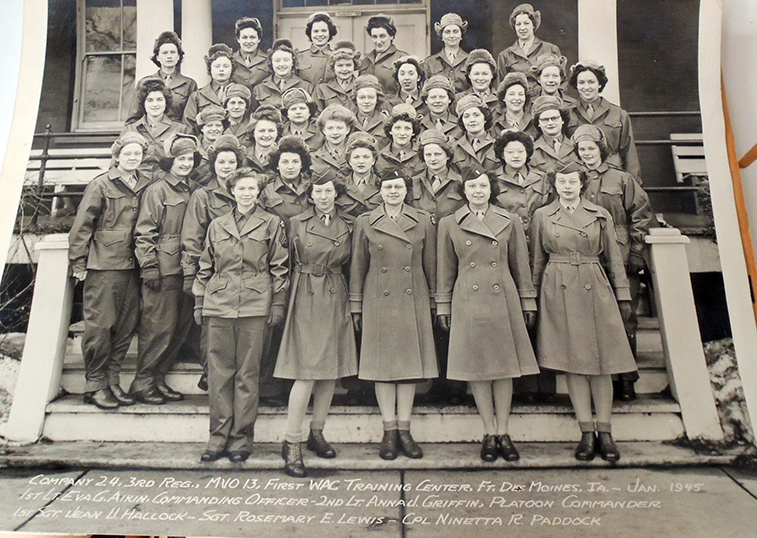
Janet Angwin’s Women’s Army Corps Album with 330 photographs and over 130 other items, 1944-46. Graphic Arts Collection. GAX 2021- in process
The Graphic Arts Collection holds a scrapbook documenting Janet Angwin’s service in the Women’s Army Corps or WAC, beginning with the order calling her up to active duty November 11, 1944, and her trip to Fort Des Moines. The album provides a personal account of the her experience in the WAC, along with detailed information on women serving in the United States Army. Included are WAC recruitment and informational pamphlets, city guides for enlisted men and women, official army memos (some mentioning Angwin by name), and the news briefs and humorous publications of the various forts where she was stationed.
Angwin was working at the Alameda Naval Air Station when she was called to active duty. At the Fort Des Moines training center she became certified to drive cargo trucks and vehicles, and was stationed in South Carolina, the Seattle Port of Embarkation, and finally Fort Lawton in Washington.
Some of the publications collected in the album are: Facts you want to know about the WAC; WAC Handbook; the “Re Port” for the Special Service Branch Charleston Port of Embarkation; Daily News Summary editions for the Charleston; and Glamour magazine pamphlet “Mustering-out Wardrobe for Servicewomen” showing what they could buy with their wardrobe allowance of $200.
Il giuoco dilettevole delli tarocchini di Bologna
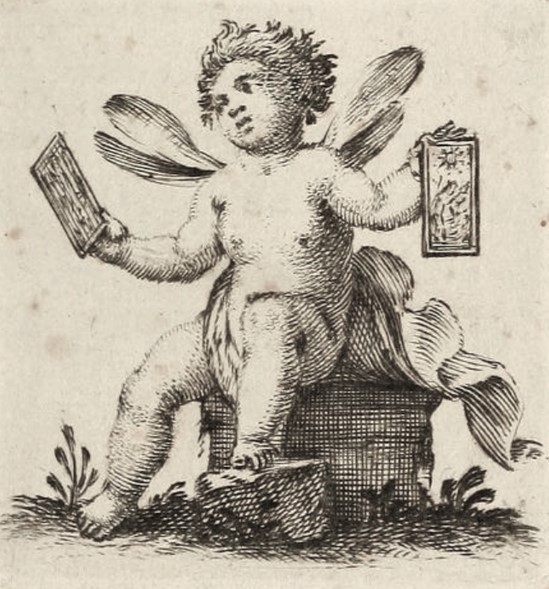
 Carlo Antonio Pisarri (ca. 1720-1780), Istruzioni necessarie per chi volesse imparare il giuoco dilettevole delli tarocchini di Bologna (Necessary Instructions for one who wants to learn the delightful game of Tarocchino in Bologna) (Bologna: Per Ferdinando Pisarri, all’Insegna di S. Antonio, 1754). Graphic Arts Collection GAX 2021- in process
Carlo Antonio Pisarri (ca. 1720-1780), Istruzioni necessarie per chi volesse imparare il giuoco dilettevole delli tarocchini di Bologna (Necessary Instructions for one who wants to learn the delightful game of Tarocchino in Bologna) (Bologna: Per Ferdinando Pisarri, all’Insegna di S. Antonio, 1754). Graphic Arts Collection GAX 2021- in process
 Chapter I: “Dell’Antichità di questo Giuoco, e come gli Antichi lo giocavano” (Of the Antiquity of this Game, and how the Ancients played it),
Chapter I: “Dell’Antichità di questo Giuoco, e come gli Antichi lo giocavano” (Of the Antiquity of this Game, and how the Ancients played it),
This early text offers the history and rules of the Tarocchino and in particular, the Bologna variation of that Tarot card game. An extended and updated history can be found with The Cultural Association “Le Tarot” at http://www.associazioneletarot.it/page.aspx?id=179&lng=ITA
“The deck Tarocco or Tarocchino Bolognese also called Carte Lunghe (Long Cards) is used in Bologna and in its province. In this case the diminutive Tarocchino means: there are not 78 cards but only 62. There are not the 2, 3, 4 and 5 of the four suits. So in the game the picture court cards are more vulnerable.”
The relationship between the author of the text Carlo Antonio Pisarri (ca. 1720-1780) and the printer/publisher Ferdinando Pisarri (active 1705-1778) is still uncertain. “Towards 1725 Ferdinando Pisarri, brother of Constantine, began to print in Bologna, at the same time as Constantine and his heirs, which often came out with very important editions, rich in tables and ornaments, not forgetting, however, editions of a more popular character.”

